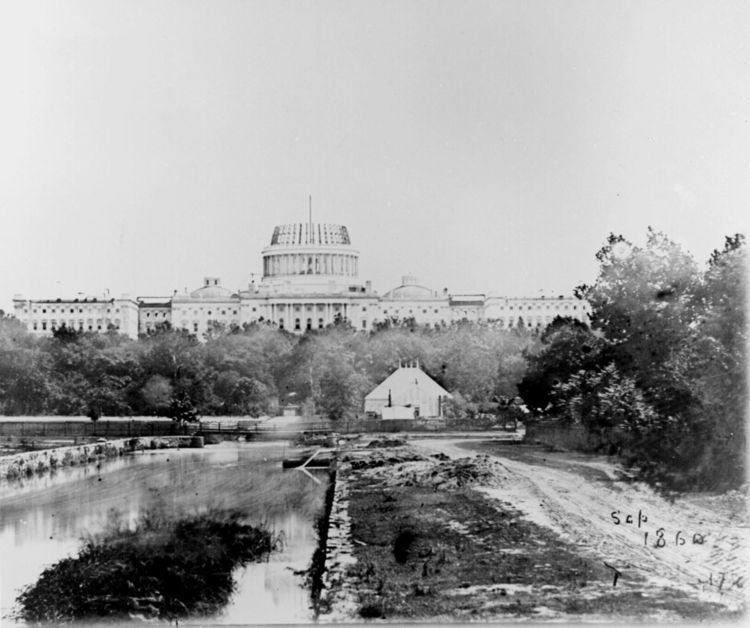The Thirty-sixth United States Congress was a meeting of the legislative branch of the United States federal government, consisting of the United States Senate and the United States House of Representatives. It met in Washington, D.C. from March 4, 1859 to March 4, 1861, during the third and fourth years of James Buchanan's presidency. The apportionment of seats in the House of Representatives was based on the Seventh Census of the United States in 1850. The Senate had a Democratic majority, and the House had a Republican plurality.
June 8, 1859: Comstock Lode discovered in the western Utah Territory (present-day Nevada)August 27, 1859: First oil well was drilled in the United States, near Titusville, PennsylvaniaOctober 16–18, 1859: John Brown's raid on Harpers Ferry beganDecember 2, 1859 John Brown executed.April 3, 1860: Pony Express began its first runApril 23 – May 3, 1860: Democratic National Convention held in Charleston, South Carolina. Unable to agree on a nominee, the delegates voted to reconvene in June.May 9, 1860: Constitutional Union Party National Convention held in Baltimore, Maryland, nominating John Bell for President.May 18, 1860: Republican National Convention held in Chicago, Illinois, nominating Abraham Lincoln for President.June 18–23, 1860: Democratic Party reconvened in Baltimore, Maryland, nominating Stephen A. Douglas for President.June 26–28, 1860: Southern Democrats held a convention in Richmond, Virginia, nominating John C. Breckinridge for President.November 6, 1860: U.S. presidential election: Abraham Lincoln beat John C. Breckinridge, Stephen A. Douglas, and John Bell.December 20, 1860: South Carolina Secession Convention enacted an Ordinance of SecessionJanuary 3, 1861: Delaware Secession Convention voted not to secede from the UnionJanuary 9, 1861: Mississippi Secession Convention enacted an Ordinance of SecessionJanuary 10, 1861: Florida Secession Convention enacted an Ordinance of SecessionJanuary 11, 1861: Alabama Secession Convention enacted an Ordinance of SecessionJanuary 18, 1861: Georgia Secession Convention enacted an Ordinance of SecessionJanuary 26, 1861: Louisiana Secession Convention enacted an Ordinance of SecessionJanuary 29, 1861. Kansas admitted to the Union as a free state.February 1, 1861: Texas Secession Convention enacted an Ordinance of SecessionFebruary 23, 1861: The people of Texas ratified its Ordinance of Secession President-elect Abraham Lincoln arrived secretly in Washington, D.C. after an assassination attempt in Baltimore, Maryland.June 16, 1860: Pacific Telegraph Act of 1860, ch. 147, 12 Stat. 41March 2, 1861: Morrill Tariff, ch. 68, 12 Stat. 178February 11, 1861: The U.S. House unanimously passed a resolution guaranteeing non-interference with slavery in any stateDecember 18, 1860: Crittenden Compromise proposedMarch 8, 1859: Quinault Treaty ratified, 12 Stat. 927March 8, 1859: Point No Point Treaty ratified, 12 Stat. 933States admitted and territories organized
January 29, 1861: Kansas admitted as a state, ch. 20, 12 Stat. 126February 28, 1861: Colorado Territory organized, ch. 59, 12 Stat. 172March 2, 1861: Nevada Territory organized, ch. 83, 12 Stat. 209March 2, 1861: Dakota Territory organized, ch. 86, 12 Stat. 239President: John C. Breckinridge (D)President pro tempore: Benjamin Fitzpatrick (D), until February 26, 1860Jesse D. Bright (D), June 12–13, 1860Benjamin Fitzpatrick (D), June 26, 1860 – December 2, 1860Solomon Foot (R), elected February 16, 1861Speaker: William Pennington (R), elected February 1, 1860Democratic Caucus Chairman: George S. HoustonThis list is arranged by chamber, then by state. Senators are listed in order of seniority, and Representatives are listed by district.
Skip to House of Representatives, belowSenators were elected by the state legislatures every two years, with one-third beginning new six-year terms with each Congress. Preceding the names in the list below are Senate class numbers, which indicate the cycle of their election. In this Congress, Class 1 meant their term began in the last Congress, requiring reelection in 1862; Class 2 meant their term began with this Congress, requiring reelection in 1864; and Class 3 meant their term ended with this Congress, requiring reelection in 1860.
The names of members of the House of Representatives are preceded by their district numbers.
The count below reflects changes from the beginning of the first session of this Congress.
Replacements: 4Democrats (D): no net changeRepublicans (R): no net changeDeaths: 1Resignations: 1Interim appointments: 1Withdrawals: 13Total seats with changes: 16Replacements: 7Democrats (D): no net changeRepublicans (R): 1 seat net lossAnti-Lecompton Democrats (LD): 1 seat net gainDeaths: 4Resignations: 3Contested election: 1Withdrawals: 28Total seats with changes: 41Lists of committees and their party leaders.
Alter and Improve Senate Chamber (Select)Amendments to the Constitution (Select)Audit and Control the Contingent Expenses of the SenateBanks of the District of Columbia (Select)Circulation of Bank Notes in the District of Columbia (Select)ClaimsCommerceComptroller William Medill (Select)Distributing Public Revenue Among the States (Select)District of ColumbiaDuties of Imports (Select)FinanceForeign RelationsFrench Spoilations (Select)Harpers Ferry Invasion (Select)Indian AffairsJudiciaryMemorial of Houmas Lands Settlers (Select)Military AffairsNaval AffairsOrdnance and War Ships (Select)Pacific Railroad (Select)Patents and the Patent OfficePensionsPost Office and Post RoadsPrintingPublic Printing Investigation (Select)Private Land ClaimsPublic LandsRetrenchmentRevolutionary ClaimsTariff Regulation (Select)TerritoriesThirteen on the Disturbed Condition of the Country (Select)WholeAccountsAgricultureClaimsCommerceDistrict of ColumbiaElectionsEngravingExpenditures in the Interior DepartmentExpenditures in the Navy DepartmentExpenditures in the Post Office DepartmentExpenditures in the State DepartmentExpenditures in the Treasury DepartmentExpenditures in the War DepartmentExpenditures on Public BuildingsForeign AffairsIndian AffairsInvalid PensionsManufacturesMileageMilitary AffairsMilitiaNaval AffairsPatentsPost Office and Post RoadsPublic Buildings and GroundsPublic ExpendituresPublic LandsRevisal and Unfinished BusinessRevolutionary ClaimsRoads and CanalsRules (Select)Standards of Official ConductTerritoriesWays and MeansWholeEnrolled BillsMaking Arrangements for Inaugurating Washington's StatueArchitect of the Capitol: Thomas U. WalterLibrarian of Congress: John Silva MeehanChaplain: Stephen P. Hill (Baptist)Phineas D. Gurley (Presbyterian), elected December 15, 1859Secretary: Asbury DickensSergeant at Arms: Dunning R. McNairClerk: James C. AllenJohn W. Forney, elected February 3, 1860Chaplain: William H. Milburn (Methodist)Doorkeeper: George MarstonMessenger: Thaddeus MorricePostmaster: Josiah M. LucasSergeant at Arms: Henry William Hoffman 
